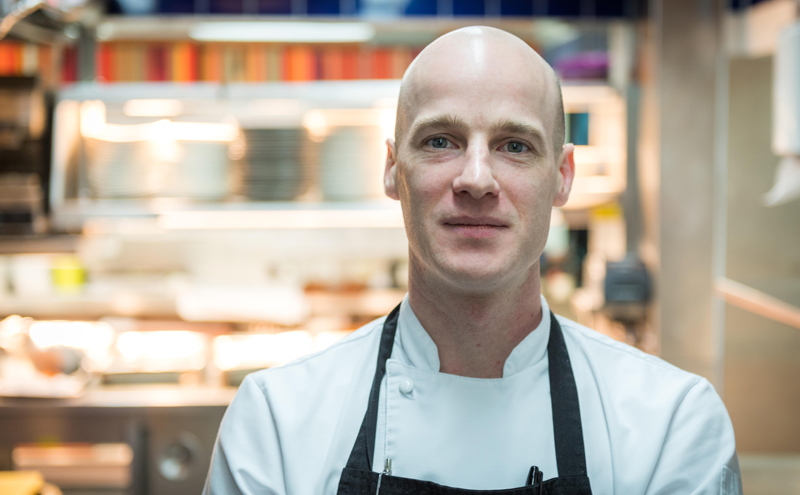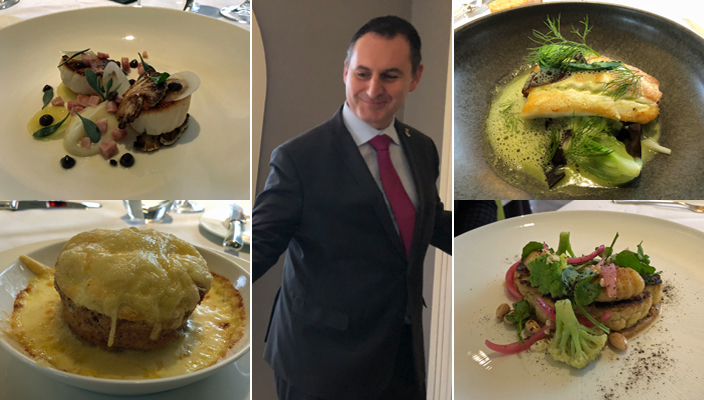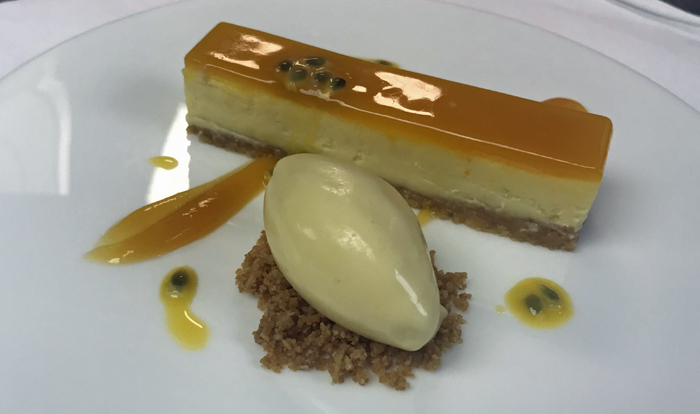This article is the second in a series designed not to provide ‘A N Other’ opinion about a chef’s output, to be lost in the now ‘me too’ sea of increasing ‘noise’ about top end dining. This is something slightly different. In this article the chef will analyse each of their dishes sampled against the five criteria used by Michelin for awarding a Michelin star. How so? Discerning foodies will recall that at The Michelin Guide GB&I launch event for the 2018 Guides, a slide was briefly discussed by Michael Ellis (WW Director of Michelin Guides), which for the first time highlighted the five criteria followed by inspectors in the awarding of Michelin Stars. Michael Ellis confirmed these under interview on that day, as a reminder he explained:-
“The first and most important criteria is the ingredients, all great cuisine starts with great product – the actual product itself is considered for freshness, quality, flavour and texture and so on. The second criteria is mastery of cooking technique. The third criteria is equilibrium and harmony in flavours; the plate must be in balance, so the sauce is not, for example, overpowering the flavour of the fish or that the seasoning of the dish is found to be exactly as it should be. The fourth criteria is regularity (or consistency) and this means starter, main and dessert are all of the appropriate standard and that each are also consistent over time. Finally, value for money is the fifth criteria.”

So here we ask Executive Head Chef Luke Matthews and The Dining Room Head Chef Simon Addison (above) to elaborate on their work at Chewton Glen Hotel’s The Dining Room.
First of all, Luke Matthews sheds some light on the challenges of delivering consistency in a large professional, luxury hotel restaurant kitchen. Luke explains that in the first instance the accent must be on the needs of the customer; so if a customer requests something, if it is possible to deliver, the first reaction is to think “yes” and then work out how. This is tough on the chefs as they need to demonstrate their flexibility, adaptability and creativity. Simon Addison added that the always something going on; lunch, afternoon tea, treehouse service, room service or buffet in the pool bar then dinner service – so keeping on top of processes and practices is vital. Chewton Glen also enjoys ‘house favourite’ classic dishes in The Dining Room that stay on the menu out of customer demand and sell in large numbers – like the twice baked Emmental soufflé on the starters, or Thai lobster curry on the main courses or The Chewton Glen honeycombe parfait with honey from the Chewton Glen estate.
The set lunch provides a vent for creating new dishes and Simon Addison explained the example of a team member getting a Hake dish on that week’s £26 for three courses set lunch menu. This creative opportunity and inclusive process raises morale and maintains focus and impetus for the whole team, Simon included.
Luke Matthews feels that The Dining Room kitchen has found that they are able to operate the menu at a consistent and sustainably high level through discipline and management. What does he mean? Well, to ensure consistency, the kitchen may have all the documented recipes, methods, processes and practices in the world but in the reality of a very large brigade of chefs in a professional kitchen, taste is the predominant consistency check; it may be a chef is not quite following the recipe, for whatever reason, and it is up to the management team in the kitchen to ensure consistent quality output to the table and that comes from “taste, taste and more tasting” – at every level, at every stage.
With value for money, Luke understands they have a little more flexibility in the Dining Room than in the more casual dining Kitchen Restaurant. In the latter volume is more critical but they do manage volume in The Dining Room too, so therefore they have scope to provide a few more luxuries on a plate. The Kitchen restaurant benefits from the same ingredient sourcing suppliers as the Dining Room, so Luke is happy that the quality standards of produce are impeccable in both outlets.

Head Chef of The Dining Room Simon Addison now takes us through each of three dishes for sourcing, cooking technique and balance and harmony on a plate. The three dishes are Scallop, Halibut and Cheesecake based. While these dishes do not specifically describe local ingredients, sourcing in this way is important to Chewton Glen, with quality of ingredient being the deciding factor. Sustainability is also key in determining a menu item, where for example, The Chewton Glen ethos is to offer only those fish which are sustainable. Simon also pointed out that the kitchen generally attempts to use as fewer added fats as possible, not ‘no butter’ but made use of in moderation.
The hand-dived scallops are sourced from a company called Keltic Seafare (http://www.kelticseafare.com/) (Orkney Islands.) Simon may ring them in the morning and next day they arrive with consistent volume and quality. To meet demand of 200-300 scallops a week, it is natural for the kitchen to maintain support suppliers, however this is predominantly only relevant in the midst of winter.

The cauliflower puree is designed to keep the natural flavours. Firstly, it is cut really fine so it cooks quickly and keeps the freshness, then vacuum packed and steamed on its own until it is cooked through, then blended with a little of its own water and a little milk added for the smoothness. Granny Smith apple is pickled for acidity, the mooli is sliced very thin on the meat slicer and shaped into a disk and compressed in a rice wine vinegar for light pickling. There are some little florets of cauliflower that have been roasted. The caper and raisin puree; equal quantities (500g) of lilliput capers and raisins – the capers are washed to reduce the level of natural saltiness, then barely cover them with water and simmer for ten minutes until everything is tender, drain them off, then blend and add a little of the cooking water back to the puree should it be needed for smoothness. The Morteau sausage is from Oakleaf (http://oakleafeuropean.com/), which is straight out of Rungis Market.
In terms of balance and harmony or equilibrium on a plate, the quality and depth of flavour will come from the sourcing of the ingredients and here it is the best, I want to enhance where possible and certainly not take away from the main ingredient. So in this dish I’m looking at flavours, textures and temperatures – The dish has the silky smooth mellow cauliflower flavour, in contrast to the roasted florets that are heavily caramelised and charred. A little smokiness from the Morteau and the acidity comes from the pickled apple and mooli. Capers and raisins bring the sweetness and saltiness.

The Halibut dish is sourced from Gigha (http://www.gighahalibut.co.uk/) who create farming pens at sea, they have a specific feed and while the fish swim they naturally (as if wild) build the texture and quality of the fish. The dish is more Asian inspired than most on the menu. Pak choi is cut into quarters, steamed in a bamboo basket, the water for the steaming is infused with lemongrass, ginger, szechuan peppercorns and garlic and so on as flavour enhancers to the steam. Some Julienne of cucumber and wasabi to create “noodles”, which are wilted very simply in a light butter emulsion (shown to a hot pan) they wilt as they rest and retain some texture, then some crab meat added, meanwhile some dulse seaweed, which tastes of the ocean – a salty flavour – is blanched in a little butter emulsion. The peelings from the cucumber used in the julienne are then blended into the beurre blanc sauce with some wasabi for a gentle heat.
The balance and harmony comes from cucumber and crab together and the saltiness of the dulse provides a form of seasoning coupled with the warmth of the wasabi assisting the beurre blanc in bringing it all together.

We use Brillat-Savarin as a core ingredient for a cheesecake, the taste I find absolutely stunning and menu wise it is a personal favourite. There are a few pivotal moments into getting it absolutely right. The first is oven temperature, the second is in the timing to use the residual heat from the oven to allow it to set. The base has some texture, it also comes with passion fruit and lime leaf – I feel it has sweet and sour, creaminess and floral, richness and acidity. It is actually something that has a significant number of behind the scenes multi-stage processes and a good number of ingredients to get it just perfect and overall to produce something on a plate that appears so simple. Perhaps the best example of what professional kitchen fine dining is really all about.
Overall, Chewton Glen’s The Dining Room restaurant offers excellent variety across a broad menu to suit multi-night guests perfectly. The addition of The Kitchen restaurant on site has expanded that variety to ensure the longer stay guests have no need to leave the property to dine for the duration of their stay. The Dining Room exudes confidence, quality and consistency combined with the service and hospitality that you can come to take for granted from The Iconic Luxury Hotels Group. Simon Addison leads a large and well drilled brigade while reporting to the long standing Executive Head Chef, Luke Matthews, who counts fifty-five employees across all food operations. As a food and beverage success story Chewton Glen goes from strength to strength.



